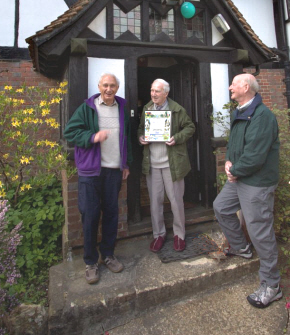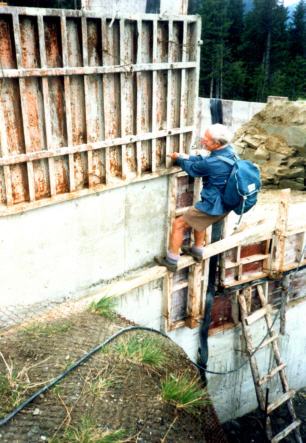
Frank, centre, receiving a plaque from Geoff King (left)
and John Smout (right) to celebrate Frank's 100th birthday on 11
May 2010. The plaque commemorates Frank's many achievements
in the world of climbing and walking, particularly in his later
years as Footpath Secretary for Tunbridge Wells Group. You
can view the plaque here.

Frank at the age of 76 in July 1986 exploring a route over a
concrete dam he and Geoff were using in the Carpathian mountains
in Romania
|
Frank Elliott MBE
Frank, who was at one time Footpath Secretary for the Tunbridge Wells
Group, enjoyed his 100th birthday in 2010.
Here his friend Geoff King, also a stalwart defender Kent's rights of
way and a leading light behind the creation of the Wealdway, outlines
Frank's life and achievements.
Frank Elliott - A Reminiscence by Geoff King
As a young rock climber in my early Peakland days, at Cratcliff Tor near Bakewell in 1947, I climbed a very exposed route needing a blind swing around a final summit nose. Full of admiration for the guy who made the first ascent, I had no idea that one day we would meet and become great friends. That guy was Frank Elliott, his name remaining indelibly etched in my memory because the climb was called “Elliotts Unconquerable”, indeed it had been known as the “Unconquerable” until Frank succeeded in climbing it; the British Mountaineering Association recognised the feat by the re-name. Twenty-five years later, on a Tunbridge Wells Rambling Club ramble, I met Frank and it was only the indelible name and association with the Peak District climb that our common interest came to light.
Frank had just retired from his job as Registrar General in Swaziland, becoming postmaster at
Flimwell, a job selected because of his early interests of climbing on the sandstone outcrops such as High Rocks & Harrison’s Rocks near Tunbridge Wells. He had fond memories of these places contributing to an appreciation and desire to live in the nearby beautiful Wealden countryside, the latter to become of vital interest in footpath protection when he became Footpath Secretary of the Tunbridge Wells Group of the Ramblers. But before these later years, Frank was to achieve a great deal more in the outdoor scene. After leaving the north to become a development engineer at Fords in Dagenham, he lived out in the Essex countryside and who should he have as a neighbour … but one Millican Dalton. Dalton was famous for his love of the Lake District, having been for health reasons advised to live the outdoor life and who, as no doubt many of you know, retired to a double bed housed in the top cave of Castle Crag near Keswick where his usual mode of travel was a raft on Derwent Water. Frank went in the opposite direction: apart from climbs in Kent he often visited the Alps and again achieved several firsts, one of which was the first crossing of the Eiger North Face, a feat which was to lead him to the summit of the Eiger where he had to help a Swiss party in difficulties, which delayed a descent, the cause for an overnight stay in an emergency bivouac dug in to a snow cave. During the night an avalanche swept poor Frank out of the cave mouth sweeping him down 1,000ft into a great snow cwm. There he lay until his companions found him next morning; they had believed him dead but thankfully they got him to hospital in Grindalwald where he spent ten days recovering mainly with broken ribs.
The war years put a temporary end to his Alpine adventures but vital tasks of a different nature became the next test for Frank; due to his experience as an engineer he became director of an Indian factory producing military equipment and vehicles for the war in South East Asia. Due to this experience Frank was invited to join the Falkland Island Dependencies Survey organizing many of the post-war expeditions with several of his exploits recorded in Sir Vivian Fuchs book “Of Ice & Men”. During his twelve years south, Frank undertook many exploits and adventures for which he was awarded the MBE and the Polar Medal. Among these exploits, was a first sledging expedition of 700 miles in 71 days completing a survey off the east coast of Graham Land. Other firsts included the first to be shot at by an
Argentinean military party during a serious Anglo Argentine incident. Frank made several first ascents on Antarctic peaks, one of which is now named after him “Mount Elliott”. It was during the descent from one of these climbs, that Frank’s party saw a strange sight, what appeared to be a dog with a square head running along a distant ridge. When catching up with the dog, its head was found to be wedged in a cardboard box; the poor creature, a sledging husky, had been missing from camp for a week and it was then realised that whilst scavenging for food, its head had become wedged thus blinding its movements. The poor creature not only had to run blindly but put up with empty sardine tins rattling about inside the box.
After a lifetime of so many anecdotal experiences, Frank’s life back in Kent may have seemed somewhat more subdued but there were many more mountaineering and walking adventures to enjoy both in Britain and in Europe, many of which I was to enjoy with him, during which, as always, his reminisces have been a pleasure to share. But typical of Frank, he did not sit back and dwell on the past but plunged into the business of caring for our splendid and unique rights of way, for that we are truly grateful as indeed as we are for so many who do likewise.
|